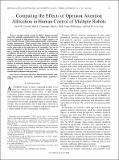| dc.contributor.author | Crandall, Jacob W. | |
| dc.contributor.author | Della Penna, Mauro | |
| dc.contributor.author | de Jong, Paul M. A. | |
| dc.contributor.author | Cummings, M. L. | |
| dc.date.accessioned | 2013-09-25T18:10:11Z | |
| dc.date.available | 2013-09-25T18:10:11Z | |
| dc.date.issued | 2011-05 | |
| dc.date.submitted | 2010-04 | |
| dc.identifier.issn | 1083-4427 | |
| dc.identifier.issn | 1558-2426 | |
| dc.identifier.uri | http://hdl.handle.net/1721.1/81173 | |
| dc.description.abstract | In time-critical systems in which a human operator supervises multiple semiautomated tasks, failure of the operator to focus attention on high-priority tasks in a timely manner can lower the effectiveness of the system and potentially result in catastrophic consequences. These systems must integrate computer-based technologies that help the human operator place attention on the right tasks at the right times to be successful. One way to assist the operator in this process is to compute where the operator's attention should be focused and then use this computation to influence the operator's behavior. In this paper, we analyze the ability of a particular modeling method to make such computations for effective attention allocation in human-multiple-robot systems. Our results demonstrate that it is not sufficient to simply compute and dictate how operators should allocate their attention. Rather, in stochastic domains, where small changes in either the endogenous or exogenous environment can dramatically affect model fidelity, model predictions should guide rather than dictate operator attentional resources so that operators can effectively exercise their judgment and experience. | en_US |
| dc.description.sponsorship | Lincoln Laboratory | en_US |
| dc.language.iso | en_US | |
| dc.publisher | Institute of Electrical and Electronics Engineers (IEEE) | en_US |
| dc.relation.isversionof | http://dx.doi.org/10.1109/TSMCA.2010.2084082 | en_US |
| dc.rights | Article is made available in accordance with the publisher's policy and may be subject to US copyright law. Please refer to the publisher's site for terms of use. | en_US |
| dc.source | IEEE | en_US |
| dc.title | Computing the Effects of Operator Attention Allocation in Human Control of Multiple Robots | en_US |
| dc.type | Article | en_US |
| dc.identifier.citation | Crandall, Jacob W., Mary L. Cummings, Mauro Della Penna, and Paul M. A. de Jong. “Computing the Effects of Operator Attention Allocation in Human Control of Multiple Robots.” IEEE Transactions on Systems, Man, and Cybernetics - Part A: Systems and Humans 41, no. 3 (May 2011): 385-397. © Copyright 2011 IEEE | en_US |
| dc.contributor.department | Massachusetts Institute of Technology. Department of Aeronautics and Astronautics | en_US |
| dc.contributor.mitauthor | Cummings, M. L. | en_US |
| dc.relation.journal | IEEE Transactions on Systems, Man, and Cybernetics - Part A: Systems and Humans | en_US |
| dc.eprint.version | Final published version | en_US |
| dc.type.uri | http://purl.org/eprint/type/JournalArticle | en_US |
| eprint.status | http://purl.org/eprint/status/PeerReviewed | en_US |
| dspace.orderedauthors | Crandall, Jacob W.; Cummings, Mary L.; Della Penna, Mauro; de Jong, Paul M. A. | en_US |
| mit.license | PUBLISHER_POLICY | en_US |
| mit.metadata.status | Complete | |
